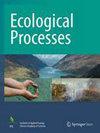对引入途径以及与非本地鱼类物种引入、建立和影响相关的特征进行全球分析
IF 3.9
2区 环境科学与生态学
Q1 ECOLOGY
引用次数: 0
摘要
引进淡水鱼类的入侵成功与否受许多因素的影响,包括生态、物种和社会经济特征。大多数记录这些特征重要性的研究都是在局部范围内进行的,并且/或者只关注入侵过程中的一个步骤。在本研究中,我们旨在确定非本地淡水鱼类入侵的物种特征、生态特征和社会经济特征。我们的评估是在全球范围内进行的,考虑了入侵的所有三个步骤(即引入、建立和影响)。为此,我们对收集到的 307 种非本地物种的 20 个变量应用了广义线性模型,并将其作为生态特征(即环境特征)、物种特征(即功能和形态)和社会经济特征(即人类使用和引入途径)的函数进行建模。我们将每个物种被引入、建立或产生生态影响的国家数量作为入侵步骤成功与否的代用指标。我们还探讨了通过水产养殖和观赏鱼贸易途径引入的物种的具体情况。我们发现,非本地淡水鱼类具有食性广泛、亲鱼照料程度高和多种引入途径等特点,是全球范围内引入和定居最广泛的鱼类。引入途径的类型(即水产养殖或渔业)最能说明受影响国家的数量。此外,在通过水产养殖引进的非本地物种中,属于鲤形目、食性广泛的物种是最广泛引进和定居的物种。相比之下,通过观赏鱼贸易途径引进的物种属于不同的分类目,但主要原产于热带地区。在分析淡水鱼类的入侵成功率和区分不同的入侵步骤时,考虑多种因素非常重要。这些发现对于预测极有可能入侵许多国家的物种概况具有重要意义。本文章由计算机程序翻译,如有差异,请以英文原文为准。
A global analysis of the introduction pathways and characteristics associated with non-native fish species introduction, establishment, and impacts
The invasion success of introduced freshwater fishes is influenced by many factors, including ecological, species, and socioeconomic characteristics. Most studies that document the importance of these characteristics are conducted at local scales and/or focus on a single step of the invasion process. In this study, we aim to determine the species characteristics, ecological characteristics, and socioeconomic characteristics of non-native freshwater fish invasions. Our assessment was done at the global scale and considers all three steps of the invasion (i.e., introduction, establishment, and impact). For this purpose, we applied generalized linear models to 20 variables collected for 307 non-native species and modeled them as a function of ecological characteristics (i.e., environmental features), species traits (i.e., functional and morphological), and socioeconomic characteristics (i.e., human use and introduction pathways). We considered the number of countries in which each species was introduced, established, or had ecological impacts as a proxy of invasion step success. We also explored the specifics of species introduced through the aquaculture and the ornamental fish trade pathways. We found that non-native freshwater fishes with broad diets, high parental care, and multiple introduction pathways are the most widely introduced and established worldwide. The number of countries with impacts reported was best explained by the type of introduction pathway (i.e., aquaculture or fisheries). Moreover, among non-native species introduced through aquaculture, those belonging to Cypriniformes and having broad diets were the most widely introduced and established species. In contrast, the species introduced through the ornamental fish trade pathway belonged to various taxonomic orders but were mainly native to tropical regions. Considering several types of factors is important when analyzing the invasion success of freshwater fish and disentangling the different invasion steps. These findings have strong implications for anticipating the profile of species with a high potential to invade many countries.
求助全文
通过发布文献求助,成功后即可免费获取论文全文。
去求助
来源期刊

Ecological Processes
Environmental Science-Ecological Modeling
CiteScore
8.50
自引率
4.20%
发文量
64
审稿时长
13 weeks
期刊介绍:
Ecological Processes is an international, peer-reviewed, open access journal devoted to quality publications in ecological studies with a focus on the underlying processes responsible for the dynamics and functions of ecological systems at multiple spatial and temporal scales. The journal welcomes manuscripts on techniques, approaches, concepts, models, reviews, syntheses, short communications and applied research for advancing our knowledge and capability toward sustainability of ecosystems and the environment. Integrations of ecological and socio-economic processes are strongly encouraged.
 求助内容:
求助内容: 应助结果提醒方式:
应助结果提醒方式:


